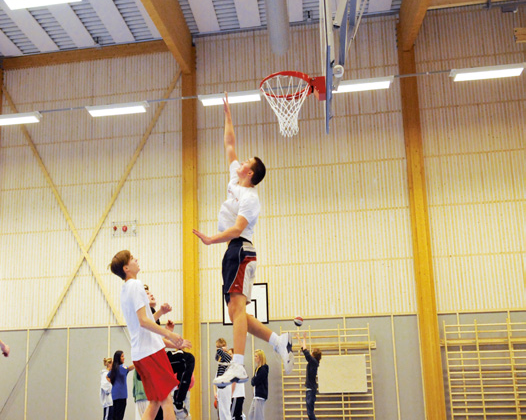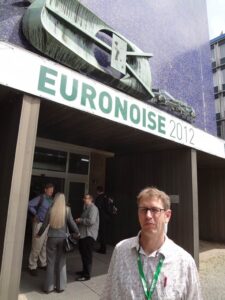
Yesterday in Prague Guus Klamerek and Monika Rychtarikova chaired an extensive session on sports halls. There was a strong focus on sports hall experience in Holland as this has been and remains a hot topic there but there were also interesting experiences from Germany and the UK.
The sessions included:
Louder than a rock concert? – Noise in sport halls as an ergonomic working condition for teachers and students
Gerhart Tiesler, Simone Lang
Gerhart explored the effects of noise on humans and the stress and chronic deregulation it causes. He recommended that the max background noise level for an unoccupied hall should be a maximum of 38 dB(A) to protect the longterm speech of teachers once the hall is occupied during activity noise.
Most sports halls measured had sound levels between 55 dB(A) and 85 dB(A) occupied peaking at excessive levels and 40-50 dB(A) unoccupied. Gerhart played the short video clip of a balloon pop made by Mikolaj Jarosz in a polish sports hall as an example of what sports halls can sound like. Gerhart then looked at the speech transmission quality over distance (m) to describe where the teachers voice could range from – relaxed, normal, raised to loud. This then puts the focs on the basic acoustic requirements and sound level control.

Reduction of noise levels in sports halls by geometrical optimisation
Vojtech Chmelik, Monika Rychtarikova, Lau Nijs, Christ Glorieux
Vojtech outline that the priority was to reduce the noise levels in sports hall but in addition explored the tilting of walls and optimising the offset wall angles.
Limitations of reverberation time with Sabine theory were not applicable in these large “shoebox” halls making it more interesting to look at the influence of reducing sound levels with “G” (dB). With a fully absorbing ceiling improvements of RT can be made by tilting one wall however little improvement is apparent if 2 parallel walls remain, also tilting walls around 5 degrees was not significant.
For the most significant effect on lowering “G” values tilting adjacent walls by 10 degrees makes a significant difference with “G” and lowering the sound levels.
Evaluation and measuring procedure for strength in sports halls
Maarten P.M.Luykx, Martijn L.S.Vercammen
Maarten focused on noise levels, the limitations of reverberation time (depending on influence of diffusion, and placement of absorption). Maarten has measured the benefits of impact resistant sound absorbing panels below 2m to reduce the disturbing horizontal sound field associated with flutter echoes. “G” (dB) must be measured and added to the speech level expected with consideration taken on the scale of the hall.
Flutter echo is disturbing but low in energy and doesn’t influence “G” making it more suitable than reverberation time to measure.
Effect of scattering objects on measured reverberation times in sports halls
Don Oeters
Don has measured many sports halls and found varying results regarding measurments and the influence of scattering objects. He found a 25-50% reduction in reverberation time when furniture is added and suprisingly 30-100% increase when furniture is removed.
So how can you design theses spaces; Sabine is not relevant due to lack of diffusivity, Fitzroy doesn’t work as the absorption is placed too high and using Ray Tracing is problematic due to the lack of sufficient data for scattering and diffusion coefficients.
In summary, make sure you have enough absorption (sabines) in the hall and place on the walls and ceiling.

Don Oeters, Arup
Sports Hall Acoustics: What is the situation in Holland?
Guus Klamerek, Lau Nijs, Martin Tenpierik
Guus updated the session with the ongoing status of the sports hall expert group discussing acoustics in sports halls. He discussed the questionnaire (read more here) the group worked with and now they would like to look into the influence of tilting walls and to find out how disturbing is a flutter echo?

Guus Klamerek, Concept Developer Ecophon NL

